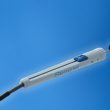Courtesy of SBHCI. This study presented at Euro PCR and simultaneously published by JACC Cardiovascular Interventions poses a question that has remained unanswered since the start of TAVR. There is little information on the optimal antithrombotic therapy after transcatheter aortic valve replacement (TAVR). In general, patients receive between 1 and 6 months of dual...
TAVR: minimalist strategy Is favorable in severe COPD
Courtesy of Dr. Carlos Fava. The presence of chronic obstructive pulmonary disease (COPD) is a criterion for which patients are ruled out for surgery and proposed as candidates for its current alternative, transcatheter aortic valve replacement (TAVR). A minimalist strategy could benefit this patient group, given the use of conscious sedation instead of general anesthesia. ...
TAVR in Intermediate-Risk Patients: Is It as Effective as Surgical Aortic Valve Replacement?
Courtesy of Dr. Carlos Fava. Transcatheter aortic valve replacement (TAVR) has proven to be beneficial for extreme- and high-risk patients. It is also increasingly used in intermediate-risk patients, and it has been hinted at for low-risk patients. However, different sectors in the medical community still challenge the existence of real TAVR benefit. This assessment consisted...
Bicuspid Aortic Valve Stenosis Still Challenging for TAVR
Courtesy of Dr. Carlos Fava One of the present challenges of TAVR is bicuspid aortic valve stenosis (AS), since it presents a different distribution and structure, associated to greater and more irregular calcification. There are only small series of devices and their use is still controversial. The study analyzed 561 patients with severe bicuspid...
Post TAVR thrombosis, is it more common than we know?
Courtesy of Dr. Carlos Fava Few post TAVR scenarios remain to be analyzed. One of them is post TAVR valve thrombosis. This event has been reported in around 0.5% of cases, but its incidence, consequences and adequate treatment remain unclear. The study analyzed 642 patients undergoing TAVR. Patients were followed up with Doppler Echocardiography...
Surgery or TAVR in intermediate risk? Results of the SURTAVI Study
Courtesy of Dr. Gustavo Leiva. Transcatheter aortic-valve replacement (TAVR) with the use of a self-expanding prosthesis is superior to medical therapy in patients with severe, symptomatic aortic stenosis in whom surgical aortic-valve replacement has been associated with prohibitive risk. Among patients considered at high risk, TAVR may be an alternative to surgery. The comparative...
Percutaneous Repair of Paravalvular Leaks After TAVR: The Challenge of Identifying Eligible Subjects
Courtesy of Dr. Carlos Fava. This study enrolled 72 patients who underwent transcatheter aortic valve replacement with an Edwards Sapiens valve, and then experienced a leak of at least moderate severity. Fifteen of them underwent a percutaneous leak repair after identification of the leak mostly through the presence of symptoms. Both groups were similar. Patients who...
Pacing with a 0.035” Guidewire, an Old Technique Coming Back to Simplify TAVR
This study seeks to prove the safety and efficacy of rapid left ventricular pacing through a 0.035” guidewire during aortic valvuloplasty and transcatheter aortic valve replacement (TAVR). Right ventricular temporary pacing placed through venous access during aortic valvuloplasty or during TAVR is time-consuming and, above all, associated with cardiac perforation and tamponade. Since...
Cerebral Protection in TAVR: Does It Improve Cognitive Function?
Neurological complications during transcatheter aortic valve replacement (TAVR) may be reduced with cerebral protection devices; this study was designed to explore that hypothesis. The study enrolled 363 patients undergoing TAVR in 19 sites and divided them in three arms: a safety arm (n = 123), a device imaging arm (n = 121), and a non-device imaging arm (n = 119). The...
Meta-analysis on Cerebral Embolic Protection in TAVR
Cerebral embolic protection is a strategy to prevent embolization of thrombotic or calcific debris during transcatheter aortic valve replacement (TAVR). A number of randomized and controlled studies have tested the safety and efficacy of various devices, though none of them have enough statistical power to show significant differences in end points. While preliminary...









